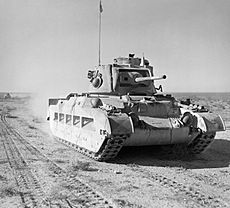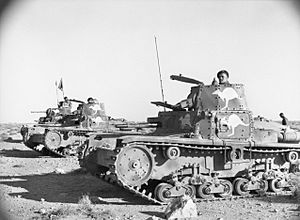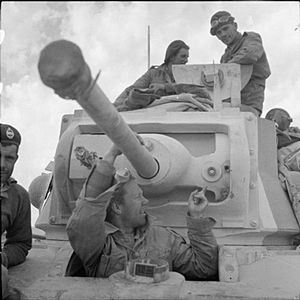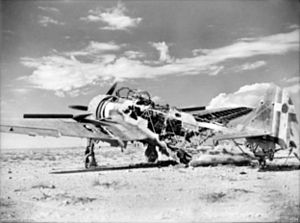Attack on Nibeiwa facts for kids
Quick facts for kids Attack on Nibeiwa |
|||||||
|---|---|---|---|---|---|---|---|
| Part of Operation Compass, during the Second World War | |||||||
 Map of the Italian invasion of Egypt |
|||||||
|
|||||||
| Belligerents | |||||||
| Commanders and leaders | |||||||
|
Pietro Maletti † | ||||||
| Units involved | |||||||
|
Maletti Group | ||||||
| Strength | |||||||
| 5,000 soldiers 47 tanks |
4,100 soldiers 23 tanks |
||||||
| Casualties and losses | |||||||
| 56 killed 27 tanks disabled/broken down |
819 killed 1,338 wounded 2,000 prisoners 28 tanks |
||||||
The Attack on Nibeiwa happened on December 9, 1940, in Egypt. During this battle, British and Indian soldiers attacked an Italian army camp. This camp was strongly defended by the Maletti Group, which was a special armored unit of the Italian 10th Army.
This attack was the first part of a bigger British plan called Operation Compass. The goal of this operation was to push the Italians out of Egypt. Italy had declared war on France and Britain on June 10, 1940. Later, in September, the Italian 10th Army invaded Egypt and reached Sidi Barrani. They then built fortified camps, including the one at Nibeiwa, about 12 miles south of Sidi Barrani.
The British had fewer troops but strong tanks. They had been watching the Italian defenses. They planned a surprise attack on the Italian camps. The main attack would be on Nibeiwa from the west. If successful, they would then attack other camps nearby. British tanks would protect the attacking soldiers from any Italian counter-attacks.
The British and Indian soldiers practiced their attack with tanks in November. They pretended to have another practice in December, but it was actually the real attack. The attack began on the night of December 9/10. The main force attacked from the west, taking the Italians by surprise. They quickly destroyed 28 Italian tanks. The Italian and Libyan soldiers fought hard, but the British tanks, artillery, and infantry slowly took over the camp. The Italians and Libyans lost many soldiers, while the British had fewer casualties. This victory at Nibeiwa was the start of the Italian army's defeat in Egypt.
Why the Battle Happened
Italy Invades Egypt
The Italian invasion of Egypt started on September 13, 1940. The Italian 10th Army moved from Italian Libya into Egypt. Their first goal was to capture the port of Sidi Barrani. This was about 65 miles away.
Two Italian divisions advanced slowly. They met British forces who fell back. On September 16, the Italian army stopped at Sidi Barrani. They built strong defensive camps there. These camps stretched from Maktila on the coast to Sofafi inland. The Maletti Group was stationed at Nibeiwa. Italian engineers worked to build new roads and bring supplies. By December, the Italian 10th Army in Egypt had about 80,000 men, 250 guns, and 120 tanks.
British Forces in the Desert
The British forces in Egypt and Palestine had about 36,000 soldiers. They also had 120 guns, 275 tanks, and 142 aircraft. The main British force was called the Western Desert Force. It included the 4th Indian Infantry Division and the 7th Armoured Division.
The British had fast Cruiser tanks with powerful guns. These were better than the Italian M11/39 tanks. The British also had Matilda II tanks. These tanks were slow but had very strong armor. Italian anti-tank guns could not easily damage them.
The Maletti Group
The Maletti Group was a special Italian armored unit. It was formed in July 1940. It included motorized infantry battalions, tanks, and artillery. It was the first combined arms unit in North Africa. This group was meant to be the main mobile force for the Italian 10th Army.
Getting Ready for Battle
The Nibeiwa Camp
Nibeiwa was about 12 miles south of Sidi Barrani. The camp was a large rectangle, about 1 by 2 kilometers. It had double stone walls and shelters. There was an anti-tank trench and a minefield around it. A gap in the north-west allowed supply trucks to enter.
The Italian army was planning to advance further east in mid-December. Italian air patrols saw British vehicle movements. However, the commander of the Maletti Group, General Pietro Maletti, was not fully informed. On December 8, Maletti warned other Italian divisions about unusual British aircraft activity. He thought it might hide troop movements. On December 9, he reported more British movements.
The British Plan
The British held a practice attack in November. It was on a model of the Italian camps. Soldiers were told another practice would happen in December. This helped them learn how to move at night and attack defenses.
The British plan was to drive between Nibeiwa and other Italian camps. Then, they would attack Nibeiwa from the west. The 11th Indian Infantry Brigade and 47 Matilda tanks would lead this attack. Other British tanks would stop any Italian counter-attacks. After taking Nibeiwa, they would attack the nearby Tummar camps.
On the night of December 6/7, the 4th Indian Division left their camp. They drove for about 50 miles. They rested on December 7, hidden from Italian planes. That evening, they were told the attack was real. On December 8, they continued their advance. By late afternoon, they were 15 miles south-east of Nibeiwa. Two battalions and the tanks moved to a position south-west of Nibeiwa. Before sunrise, they were ready to attack.
The Battle Begins
British planes bombed the Italian camps all night. This helped hide the sound of British vehicles moving on the ground. It also kept Italian planes from taking off. At 3:00 a.m., Indian soldiers approached the camp on foot. They met Italian listening posts and fighting began. The Italians fired flares and shot back.
Under cover of this noise, British tanks and trucks moved around to the west side of the camp. At 6:00 a.m., the Indians on the east side pulled back. British artillery started firing from the east to mislead the Italians. At 7:15 a.m., the artillery of the 4th Indian Division fired on Nibeiwa from the south-east.
At 7:30 a.m., the British tanks began their attack. They were supported by artillery and Indian infantry. The Italians had gathered their 28 M11/39 tanks outside the camp walls. The tank crews were warming their engines when the attack started.
The Italian tank crews had no time to react. Their tanks were quickly destroyed. The British tanks broke through the camp walls and drove inside. The Italians had just finished breakfast. General Maletti tried to fight with a machine-gun but was killed.
At 7:45 a.m., British and Indian infantry followed in trucks. They stopped 700 yards away, got out, and charged into the camp. Italian and Libyan artillerymen stayed at their guns. But even their shells fired from close range could not damage the strong armor of the Matilda tanks. The Italian and Libyan infantry fought on. Some tried to attack British tanks with hand grenades. But the British systematically took over the camp. Tanks, artillery, and infantry worked together to defeat the remaining resistance. By 10:40 a.m., the battle was over. The British found large amounts of supplies and water untouched.
After the Battle
Who Won and What Was Lost
The British took 2,000 Italian and Libyan soldiers as prisoners. They also captured many supplies and water. The British lost 56 men. Italian records show that 819 Italian and Libyan soldiers were killed, including General Maletti. Another 1,338 men were wounded.
What Happened Next
The British attack on Tummar West began at 1:50 p.m. The tanks refueled, and artillery fired for an hour. The tanks broke through the defenses, and infantry followed. The defenders fought longer than at Nibeiwa. But by 4:00 p.m., Tummar West was mostly captured.
The tanks then moved to Tummar East. Most of this camp was captured by nightfall. Other British armored units moved to cut off Italian escape routes. The Italian 2nd Libyan Division lost many officers and men. The remaining soldiers were taken prisoner. The success at Nibeiwa led to the collapse of the Italian position in Egypt.
See also
- List of British military equipment of World War II
- List of Italian military equipment in World War II





